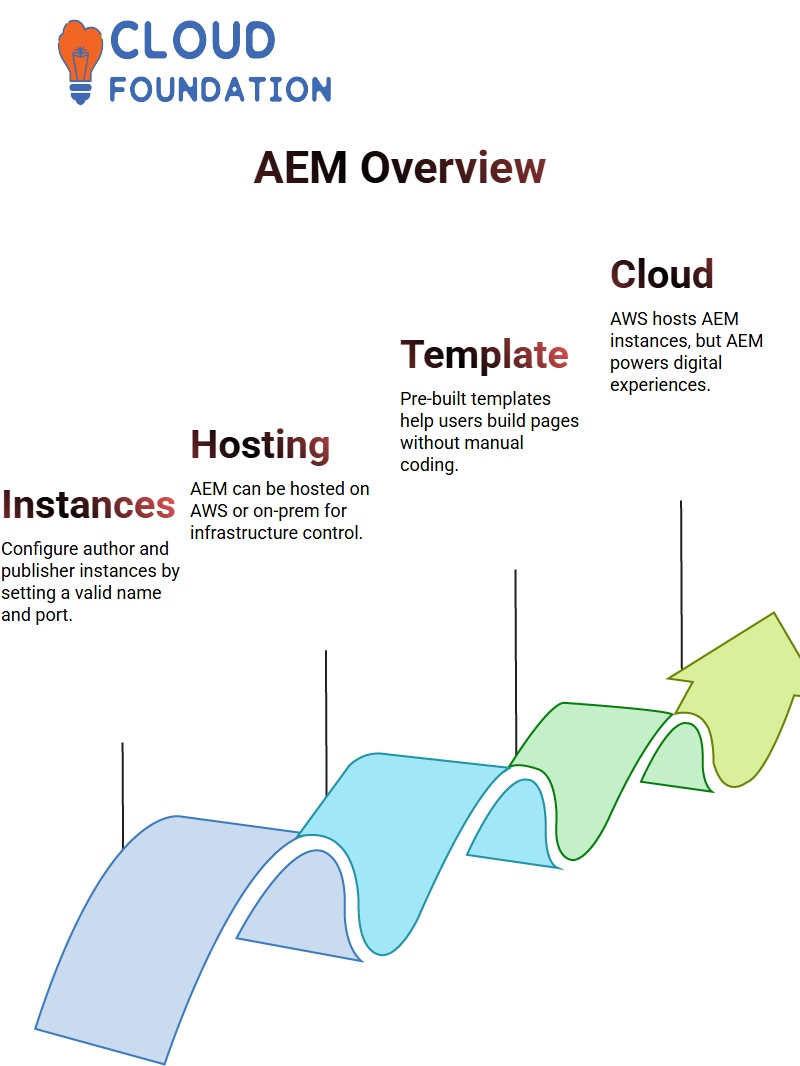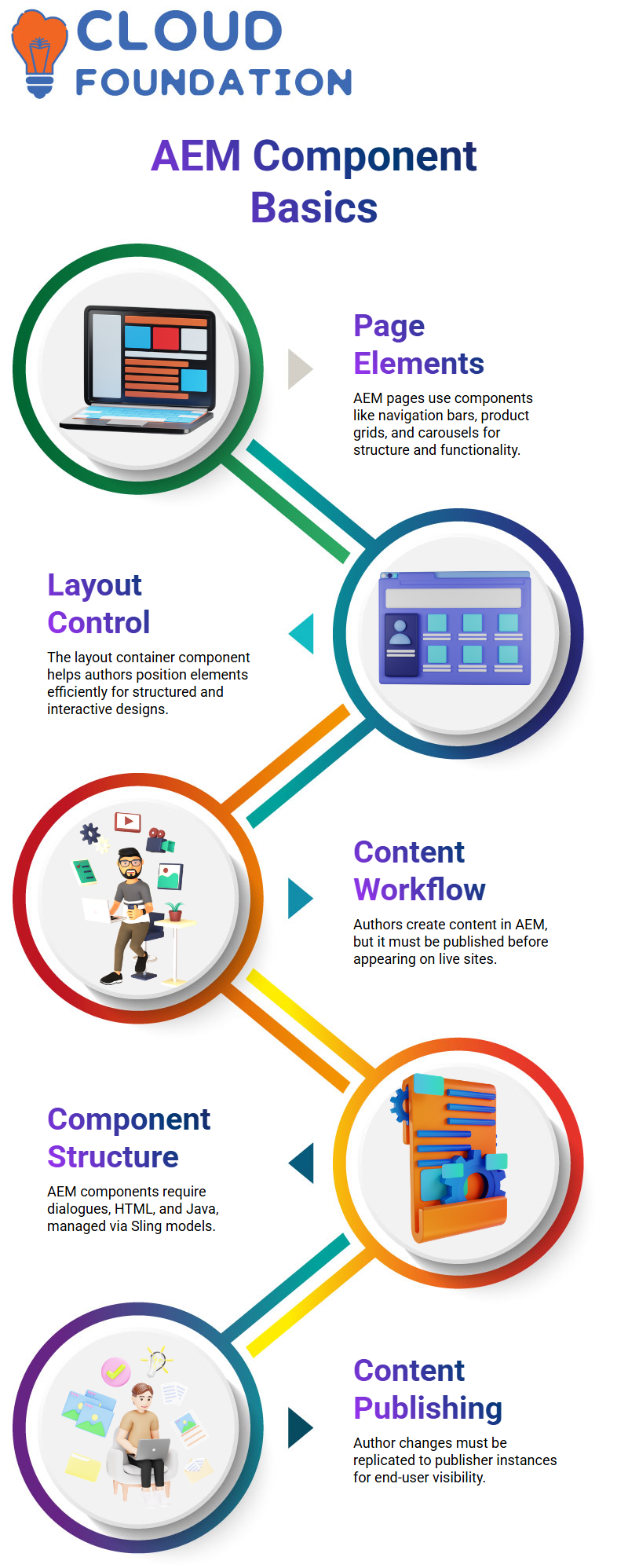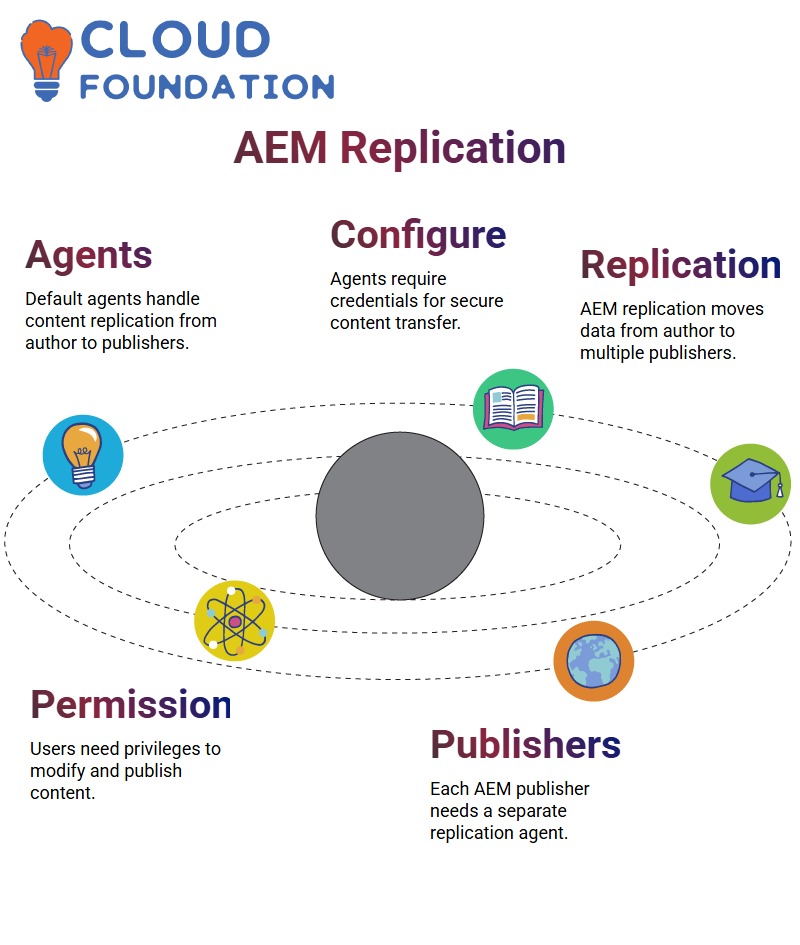AEM Development PDF
Understanding CRUD Operations in AEM
Mastery of AEM CRUD operations –create, read, update, and delete–is essential when working with AEM. Let me walk through how these operations function within AEM.
In AEM, we mainly rely on two APIS – Sling API and JSON interface.
Both models provide different methods for handling resources, and one must understand these differences to complete tasks effectively.
Using Sling API in AEM
AEM uses its Sling API as a powerful resource management tool. Its methods allow for retrieving child resources or accessing properties.
Utilise it by calling methods like resource.getChildren() or consulting value maps on specific resources.

As an example, AEM makes these operations simple and user-friendly for developers. For instance, when retrieving resources or fetching children they provide, and reading properties via value map retrievals.
Using JSON Interface in AEM
AEM also features the JSON interface, which works seamlessly with nodes and sessions.
Nodes allow you to manage resources using node.getProperties() and session.save(), giving you greater insight into the structure of your content.
Nodes act like interchangeable resources, allowing for greater analysis into how they relate.
Modifying properties using AEM’s JSON interface allows you to update values within its value map nodes and commit your changes securely and reliably.
AEM provides robust support to make these modifications reliable.
Adding and Modifying Properties in AEM
Adding properties in AEM is as straightforward as updating its value map. Your resource already contains three properties—first, second, and third.
To add another, update its value map before committing it using session management.
AEM allows users to set modifiable properties, making dynamic updates simple. Whether you’re adding, editing, or committing changes, AEM has your back!
Deleting Resources in AEM
Deleting resources in AEM is easy. Identify the resource to be deleted before calling its delete method and making your change official.
For instance, if your resource contains grandchildResource, AEM will update the session to reflect this change, and you can remove this resource accordingly.
Our process is seamless and allows you to manage your content efficiently.
Understanding AEM Resource Adaptation
Explore something that has caused me difficulty using AEM: adapting modifiable value maps instead of regular ones.
At first, it seemed the issue lay elsewhere, but after further experimentation, I discovered that adapting modifiable value maps was key in solving my difficulties.
Handling Node Properties in AEM
How AEM allows us to retrieve and modify properties efficiently. We can efficiently retrieve properties with modifiable value maps by adopting child resources.
Setting values may seem simple enough, but remember that you can change multiple properties simultaneously for faster operations.
Deleting Resources in AEM
Deleting resources in AEM is easy; locate it, call its delete method, and watch as it disappears.

This method works seamlessly with the Sling API, making resource management more manageable.
AEM API Choices: Sling vs JCR
Picking between Sling and JCR APIs in AEM can be challenging.
Both services achieve similar goals, yet Sling provides a more intuitive operation than JCR – this explains why many developers favour adapting resources using Sling models.
AEM Performance Considerations
Performance matters when working in AEM, and both the Sling API and the JCR API provide great flexibility.
However, JCR delivers direct access to nodes, which may prove more suitable for performance-critical tasks.
In any event, it all boils down to striking the right balance between usability and efficiency.
Best Practices for AEM Development
One key insight has been learning when to utilise modifiable value maps, session commits, and direct node modifications based on individual resource adaptation requirements.

Each method serves a distinct function.
Enhancing Development with AEM
Working with AEM simplifies development thanks to its powerful utility classes and features.
Experience with AEM’s Adapt to framework has shown its invaluable applications.
Similarly, AEM resources and utility functions offer extensive options to manipulate and manage content seamlessly.
Utilizing AEM’s resource utilities, you can quickly and efficiently create or modify resources, retrieve existing ones, generate any missing ones automatically, if necessary, simplify coding processes while decreasing effort, and improve workflow efficiency.
How AEM Leverages Sling API
Behind the scenes, AEM relies heavily on the Sling API, an extension of JCR APIS.
While working within AEM, you indirectly employ JCR APIS through the Sling framework, taking advantage of additional functionalities to increase development productivity.
Sling API offers developers an efficient means of interacting with resources.
However, execution still occurs through JCR APIS, so performance depends on using direct GCR calls in complex operations.
Performance Considerations in AEM
Understanding the interactions between the Sling API and the JCR API is vital when optimising performance within AEM.
While Sling API facilitates development, JCR APIS provide superior resource optimisation performance in resource-intensive tasks.
Tapping directly into JCR can ensure efficiency and success if your operations involve complex processes.
Sling API can often speed development without compromising functionality, while JCR APIS may offer greater performance advantages in more demanding scenarios.
Developers must assess their needs and select a practical approach to maintain efficiency within AEM projects.
Understanding AEM: The Core of Enterprise CMS
AEM lies at the core of enterprise content management systems. With its flexible architecture and efficient capabilities for overseeing digital experiences, AEM provides maximum flexibility while remaining efficient for business use.
Here, we explore what AEM is, how it operates as a CMS, and its significance within enterprises.
One of AEM’s core strengths is its component-based structure.
When adding pages, there is no need to write extensive code—AEM allows authors to build and modify them on demand.
Setting Up AEM Instances: Author and Publisher
Establishing author and publisher instances within AEM is straightforward. When creating an instance, specify an applicable name and port to instantly configure it.
Example: We created two instances—author on port 4502 and publisher on 4503—which play key roles in effectively managing content.
AEM Hosting: Cloud vs. On-Prem
One of the more frequently asked questions about AEM hosting involves whether its instance runs on AWS cloud or on-premise servers.

While AWS provides physical space to house AEM, AEM itself serves as an application server that powers digital experiences.
On-prem hosting allows companies to run AEM instances on local servers within their premises for complete control over infrastructure.
AEM Sites and Pages: Building Without Code
AEM provides its users with pre-built templates and reference websites to assist in creating pages dynamically using templates. No coding necessary—AEM generates pages automatically.
Example: Selecting an AEM template to build a page can be crucial in producing instant pages without writing HTML from scratch.
AEM Components: The Building Blocks
Pages created using AEM are composed of various components. Navigation bars, product grids, and carousels shape the visuals and functionality of websites created using this platform.
AEM provides authors with an efficient means of organising their designs through its layout container component.
This component allows for quickly adding and positioning additional elements to create organised, user-centric pages.
AEM Author vs. Publisher: Content Workflow
Authors create and update pages within AEM’s author instance, but these changes are not visible until published to the live site.

A new page created within the author instance does not automatically appear on its publisher instance until published, ensuring a controlled workflow.
Understanding AEM Components
Building components with AEM typically involves three essential steps: dialogues, HTML markup and Java coding, with Sling models used to manage this part.
All three aspects must work seamlessly for successful component development within AEM; let’s consider each in detail below.
AEM’s dialogue feature is essential in providing authors with inputs that directly shape website outputs.
For instance, updating text in an author instance reflects your input but may take up to 24 hours to appear on the publisher instance.
To ensure our content reaches end users, it must be disseminated through replication to all publisher instances.
How Content Replication Works in AEM
Replication in AEM ensures that updated content from an author instance is accessible across all publisher instances.
Whether using the “Publish Page” option or selecting and activating pages directly, this process is effortless.
We aim to synchronise all publisher instances quickly to efficiently deliver fresh, up-to-date content.
As soon as you publish in AEM, its dispatcher becomes indispensable for load balancing user requests across publisher instances.
Replication ensures users always receive the latest content. Although terms like ‘publish, activate, or replicate’ can often be used interchangeably when discussing replication, they all serve the same function.
Configuring Publishers in AEM
Configuring publishers within AEM involves specifying their number and ports for operation; for instance, if your publishers run on port 4503, AEM needs to know this to recognise them correctly.
You can access these settings through the “Replication” section under deployment options.
AEM employs replication agents as travel agents, managing content packages from author to publisher as part of this process.
Agent configuration includes information regarding publishers, such as ports and credentials, for an efficient content migration experience.
Exploring Reverse Replication in AEM
Reverse replication requires content to flow back from publisher instances to author instances, and AEM can support this feature by configuring agents on both publishers and authors instead.
Reverse replication in AEM is managed through publishers using agents on publishers who package up content from publisher instances and transfer it back to authors for replication purposes.
Although less commonly utilized than standard replication, reverse replication remains an effective feature that provides robust solutions in certain use cases.
Using Default Agents in AEM
AEM default agents play a pivotal role in content replication. These default agents, preconfigured to perform replication tasks like moving content from authors to publishers, can be seen by accessing AEM’s ‘Agents on Author’ section.
Configuring credentials and details related to content transfer ensures a safe, efficient experience. If necessary, you may choose to adapt these settings according to your project’s needs.
Understanding AEM Replication
Replicated AEM content delivery relies on its replication agent to transfer information from an author instance to multiple publishers correctly and reliably.
Replication agents are indispensable in ensuring content is migrated successfully across AEM instances and publishers.

Every AEM user engaged in replication requires sufficient permissions to create, modify, and publish packages to AEM publishers.
Without these rights, replication fails, and content remains stuck within its author instance.
Setting Up AEM Publishers and Agents
Configuring multiple AEM publishers involves configuring replication agents for each.
Therefore, in an environment with three AEM publishers present, three replication agents need to be configured – one per publisher.
AEM does not support using a single replication agent to migrate content between publishers.
Instead, it uses separate agents who handle this migration so that each publisher receives the appropriate content and updates.
Creating AEM Agents Through CRXD
AEM provides tools for agent creation, including the Configure Replicated Exchange Datasets (CRXD). These tools enable users to locate replication settings and set up new agents for various publishers.
Users can efficiently set up new publishers by duplicating and editing an AEM replication agent’s default configuration settings before duplicating that agent again with modified settings for new publishers.
Adjusting the replication target helps ensure that AEM content goes to its designated instances.
Managing AEM Deployment
Implementation of AEM code requires special care; unlike content deployment, AEM code needs to be individually deployed on each instance, whether that means one author or multiple publishers.

AEM teams typically deploy AEM using automated tools like Jenkins. Manual deployment should ensure AEM runs consistently across all instances if such automation is unavailable.
Handling Dispatcher Configuration in AEM
Publishers typically use dispatcher caching in AEM. AEM websites receive thousands of page requests daily, making caching essential to performance optimisation.
While some organisations explore dispatcher configurations for AEM author instances, this remains relatively rare.
AEM authors typically serve a limited set of users, eliminating the need for dispatcher-level caching.

Sai Susmitha
Author



